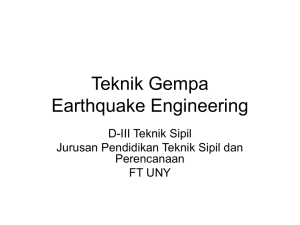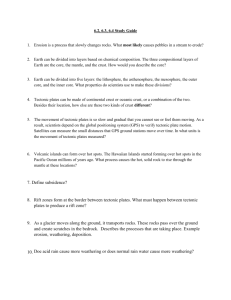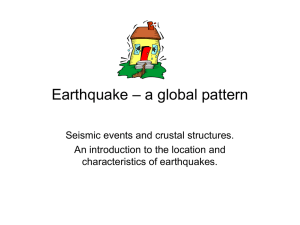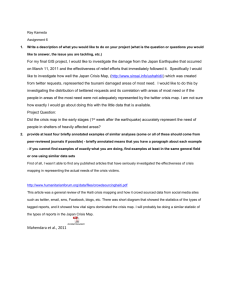Owen Davies Plan Relationship of case studies Definitions
advertisement
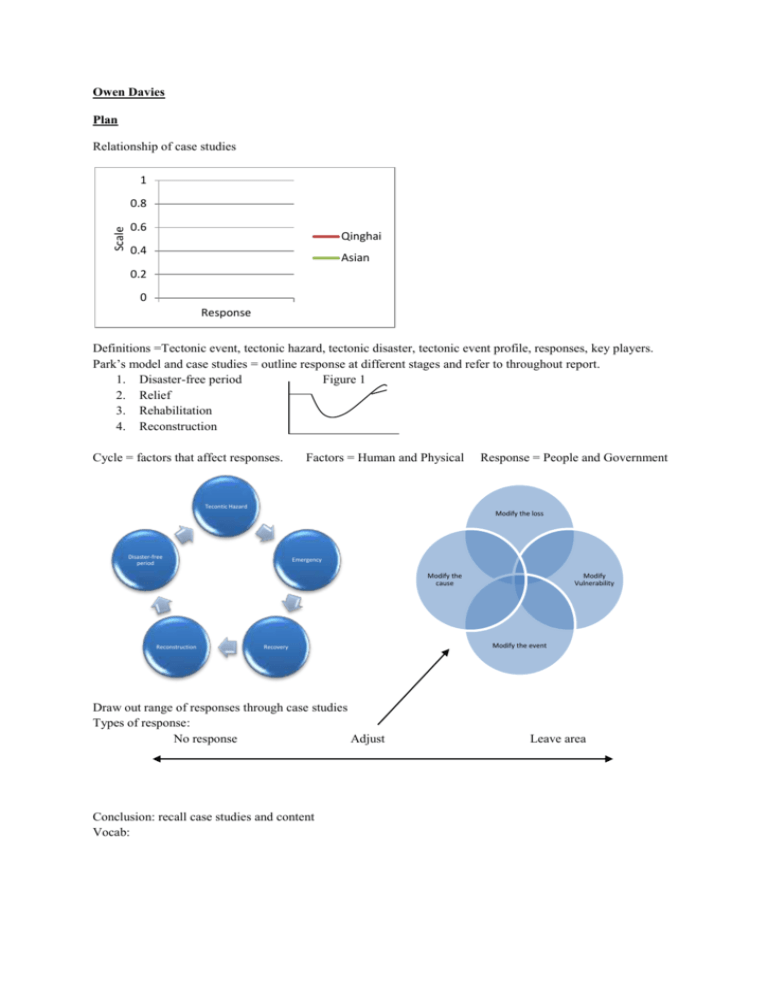
Owen Davies Plan Relationship of case studies 1 Scale 0.8 0.6 Qinghai 0.4 Asian 0.2 0 Response Definitions =Tectonic event, tectonic hazard, tectonic disaster, tectonic event profile, responses, key players. Park’s model and case studies = outline response at different stages and refer to throughout report. 1. Disaster-free period Figure 1 2. Relief 3. Rehabilitation 4. Reconstruction Cycle = factors that affect responses. Factors = Human and Physical Response = People and Government Tecontic Hazard Modify the loss Disaster-free period Emergency Modify the cause Reconstruction Recovery Draw out range of responses through case studies Types of response: No response Adjust Conclusion: recall case studies and content Vocab: Modify Vulnerability Modify the event Leave area Introduction A tectonic event is a physical occurrence resulting from the movement or deformation of the earth’s crust. They are predominantly earthquakes or volcanic eruptions and their associated activities. Such events become tectonic hazards when they have the potential to cause loss of life and damage to property. This then becomes a tectonic disaster when an event materialises and causes extrusive destruction and fatalities 1. Therefore, a tectonic event profile is a diagram that tries to represent the characteristics of different types of hazard. These characteristics are magnitude, speed of onset, duration, areal extent, spatial predictability and frequency. It’s useful for making comparisons between different tectonic events. Responses have transferred since the end of the twentieth century from developing humanitarian response and long term recovery, such as in Armenia 1998, to more mitigation and reduction of vulnerability led by the UN and 2005 Hyogo framework. The title requires a consideration of factors that affect responses. In general, the types of response are: No response Adjust Leave perm/temp Tectonic event profiles, human and physical factors affect response. There are inequalities in modifying vulnerability which will be examined in this report. The responses to natural hazards involve key players that have differing roles in a cycle of before, during and after an event. This management cycle is shown below. Tecontic Hazard Figure 1 Disaster-free period Emergency PARKS MODEL GOES HERE Reconstruction Recovery Parks model (figure1) will be referred to throughout this report to outline the factors that affect response as well as contrasting case studies to draw out the range of responses such as the operations of Mt Etna (1992) and more recent evacuations of Mt Merapi (2006) compared with the ‘do nothing approach’ of volcano Nevada del Ruiz in modifying the event. The tsunami in the Indian Ocean (2004), a catastrophic Tsunami within an underdeveloped region that lacks resources to show how immense frequency and magnitude can command local and international response and how players can modify vulnerability, contrasted with Qinghai (2010) earthquake, a remote, mountainous region where a transition economy attempted to modify the loss. The Case Studies were selected by researching reputable sources then deciding which ones were bias and casting them out… 1 Reference: Edexcel A2 Geography Dunn Et al Section 1 – factors affecting response and the response generated 1.1 Disaster free period Park’s model (Nick Park, Lancaster University) can be used to describe the phases of the hazardous event and the responses made by key players at these different phases. In the disaster free period there are a range of factors that affect the planning of responses by people and government. Tectonic event profiles of previous tectonic hazards can be used to predict the impact and likely hood of a future event and therefore prepare response. This can be illustrated through Haiti (2010) and Mount St Helens (1980). Magnitude Speed of onset Duration Areal extent Spatial predictability Frequency Enormous Rapid Long Widespread Random Frequent E V Just above Slow Short Limited predictable Very rare Due to Haiti’s high magnitude, frequency and speed of onset, response by key players will be high in terms of proving earthquake resistant buildings and so on. St Helens high predictability, large areal extent and long duration will mean key players will respond with greater planning for a greater impact. However, tectonic event profiles are influenced by human and physical factors. For example, Magnitude and Population density – A high magnitude volcano in a low populated area would involve little response. Countries must have the competence and resources, otherwise planners will have to look for national and international help in planning resources. Although, tectonic event profiles are unreliable as tectonic events are unpredictable. E.g. Just because an earthquake hasn’t struck in California for decades, doesn’t mean there won’t be one tomorrow. During pre-disaster, key players can respond by modifying the cause of the event. This can be done through environmental control and hazard prevention. However this is only really possible for small scale hazards, landslides and floods. They can also modify the event for example Mt Etna 1992 eruption. The Marines called it Operation Volcano Buster. Dams were built to contain its lava however eventually broke. Joint Italian-American operations used explosives to blow a hole in the lava tunnel 6,000 feet up Mount Etna. Then, a helicopter carried the huge concrete blocks into position around the hole and knocked them in that seemed to block the flow. However, in other cases such as Mt Merapi 2006, response was to ‘leave temporarily’. On April 12th Authorities put the volcano's surrounding villages on high alert and local residents prepared for a likely evacuation. By early May, active lava flows had begun, thus the authorities ordered the immediate evacuation of all residents on the mountain. However, in some cases key players do not response and ‘do nothing’. For example a 3 VEI eruption in Nevado Del Ruiz 1985 that produced pyroclastic flows and generated 4 lahars. Scientists did not know precisely when the eruption would occur, and the authorities would not take costly preventative measures without clear warnings of imminent danger. Local authorities failed to alert people to the seriousness of the situation. The ash stopped falling so people became calm, however the volcano erupted which could not be seen due to a storm. 1.2 Tectonic/hazard event, relief and rehabilitation Once the tectonic event occurs, the relief stage begins which involves search, rescue, care and vulnerability strategies. The relief stage sees the deterioration of quality of life, level of economic activity, social stability, communication and services. Therefore key players attempt to modify the loss which is affected by physical and human factors. Type of hazard •Scale, impact and magnitude Topography of region Degree of comunity prepardness Government competence and resources Scientific understanding Human •E.g Mountainous education and training Infrastructure Climate •Monsoon rain causes access problems to rescuers Level of development For example, Qinghai, a mountainous remote region with a population of 80000 that suffered a 7.1M earthquake this year. 400 people were killed and 85% of buildings were destroyed according to the telegraph. The response came from: 1. National & Local government – were aiming to clear debris within weeks and rebuild within 3 years 2. Emergency services – 700 soldiers sent from PLA and rescue teams flown in from China that were trained from the Sichuan earthquake. 10000 were already there. Efforts were hindered by road slides and debris blocking roads. 3. Relief Agencies – Cornwall based disaster relief charity sent tents - British Red Cross sent 500 tents and 1000 quilts 4. Media – Jackie Chan charity gig raised £3.3million BBC news 5. Scientists – Ni Sidao University of science and technology - more preparedness 6. Insurers - 1,600 orphans have received one year of free medical insurance for 12 critical illnesses thanks to joint efforts by the government and charity organizations. However, even though China has huge amounts of resources, due to its topography, location and population it was therefore difficult for players to respond. In contrary to this is the Asian Tsunami. This example shows how a high frequency and magnitude can dictate huge response in a low economically developed country. On 26 December 2004, an 8.9M earthquake generated a tsunami destructing much of the rim of the Indian Ocean killing 300000 according the UN. The people and governments of Sri Lanka and Indonesia were overwhelmed by the enormity of the catastrophe, and so due to its magnitude response was huge. International governments and NGOs supplying relief were essential. Communities bottom up approaches by the UNDP and other player’s for disaster preparedness and reconstruction. Huge amounts of aid from various countries were brought in. However a leading international charity says the poorest have benefited the least from relief as it’s gone to the rich. 1.3 Reconstruction This stage involves the permanent rebuilding of physical and social infrastructure and is normally carried out locally however the Asian Tsunami was international. It involves reducing future vulnerability by learning lessons. While no one could have prevented the Asian tsunami, key players can use this experience to prevent some of the destruction future events will cause. The WWF stated ‘mangroves can limit the destruction in less hit areas’ which was proved by scientists. Therefore mangroves were protected and replanted to modify the vulnerability. Also the setting up of TWS, giving information & education pre-event tries to address reduction on vulnerability. Other players include planners, engineers and architects. However, there are inequalities in modifying vulnerability. Wealthier economies (USA) have more technological fixes such as aseismic buildings and emergency services. Reconstruction happens everywhere, but funding in weaker economies is worse where insurance is rare. On the other hand is this really correct due to the success of Qinghai’s response? After reconstruction things can either go back to normality or improve. They can feed learning into improving risk assessment, vulnerability assessment & strategy for response for future events. Conclusion Chaf shit here Websites: www.sciencedaily.com/mangroves www.chinadigitaltimes.com/qinghai the Geography review journal, textbooks, newspaper article, website, video

